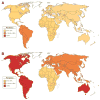Comparison of the Phenotype and Approach to Pediatric vs Adult Patients With Nonalcoholic Fatty Liver Disease
- PMID: 27003600
- PMCID: PMC4887388
- DOI: 10.1053/j.gastro.2016.03.009
Comparison of the Phenotype and Approach to Pediatric vs Adult Patients With Nonalcoholic Fatty Liver Disease
Abstract
Nonalcoholic fatty liver disease (NAFLD) is one of the main chronic noncommunicable diseases in Westernized societies; its worldwide prevalence has doubled during the last 20 years. NAFLD has serious health implications not only for adults, but also for children. However, pediatric NAFLD is not only an important global problem in itself, but it is likely to be associated with increases in comorbidities, such as metabolic syndrome and cardiovascular diseases. There are several differences between NAFLD in children and adults, and it is not clear whether the disease observed in children is the initial phase of a process that progresses with age. The increasing prevalence of pediatric NAFLD has serious implications for the future adult population requiring appropriate action. Studies of NAFLD progression, pathogenesis, and management should evaluate disease phenotypes in children and follow these over the patient's lifetime. We review the similarities and differences of NAFLD between children and adults.
Keywords: Adults; Children; Nonalcoholic Fatty Liver Disease; Nonalcoholic Steatohepatitis.
Copyright © 2016 AGA Institute. Published by Elsevier Inc. All rights reserved.
Conflict of interest statement
Figures
References
-
- Loomba R, Sanyal AJ. The global NAFLD epidemic. Nat Rev Gastroenterol Hepatol. 2013;10:686–690. - PubMed
-
- Nobili V, Svegliati-Baroni G, Alisi A, et al. A 360-degree overview of paediatric NAFLD: recent insights. J Hepatol. 2013;58:1218–1229. - PubMed
-
- Masarone M, Federico A, Abenavoli L, et al. Non alcoholic fatty liver: epidemiology and natural history. Rev Recent Clin Trials. 2014;9:126–133. - PubMed
-
- Brunt EM. Pathology of nonalcoholic fatty liver disease. Nat Rev Gastroenterol Hepatol. 2010;7:195–203. - PubMed
-
- Moran JR, Ghishan FK, Halter SA, et al. Steatohepatitis in obese children: a cause of chronic liver dysfunction. Am J Gastroenterol. 1983;78:374–377. - PubMed
Publication types
MeSH terms
Grants and funding
LinkOut - more resources
Full Text Sources
Other Literature Sources
Medical
Molecular Biology Databases


